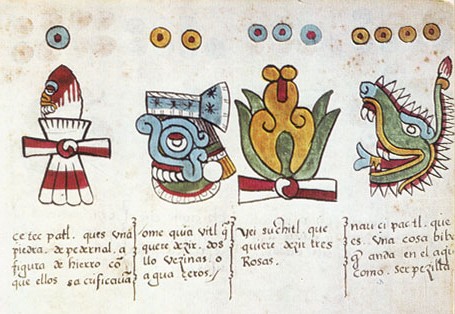Codex Magliabechiano (141 cropped).jpg on:
[Wikipedia]
[Google]
[Amazon]
 The Codex Magliabechiano is a pictorial
The Codex Magliabechiano is a pictorial 
File:Codex Magliabechiano 11R.jpg, The first four day-symbols of the '' tonalpohualli'': Flint, Rain, Flower, Crocodile. (Page 11, reverse) (the Rain day-symbol resembles symbol of Tlaloc)
File:Codex Magliabechiano folio 11v.jpg, Depicts the Aztec calendrical signs for the days 5 Wind, 6 House, 7 Lizard and 8 Snake. (Folio 11v)
File:Codex Magliabechiano folio 12r.jpg, Calendrical signs for the days 9 Death, 10 Deer, 11 Rabbit and 12 Water. (folio 12r)
File:Codex Magliabechiano folio 13r.jpg, Calendrical signs for the days 4 Jaguar, 5 Eagle, 6 Vulture and 7 Quake. (Folio 13r)
File:Codex Magliabechiano (141).jpg, page 141 (folio 70r)
File:Codex Magliabechiano (141 cropped).jpg, page 141 (folio 70r)
File:Magliabechiano funeral.jpg
File:Magliabchanopage 73r.jpg, A depiction of cannibalism in Aztec culture. (Folio 73r)
File:Magliabechiano medicine.jpg
File:Magliabechiano tititl.jpg, Possibly depicting Tititl festival
File:Chicomecoatl 2.jpg
File:Codex Magliabechiano ritual sacrificial combat.jpg
File:Jaguar warrior.jpg, Victim of the ritual sacrificial combat named ''Sacrificio Gladiatorio'' in spanish and ''Tlahuahuanaliztli'' o ''tlauauaniliztli'' in nahuatl, as portrayed in the folio 30r
File:Toltecatl.jpg,
SVG renderings
Image:Calli (house).svg
Image:Tochtli.svg
Image:Xochitl.svg
Image:Mazatl.svg
Full pages of icons
Icons
Image:Acatl.jpg
Image:Cipactli.jpg
Image:Coatl.jpg
Image:Cozcacuauhtli.jpg
Image:Cuauhtli.jpg
Image:Cuetzpalin.jpg
Image:Ehecatl2.jpg
Image:Itzcuintli.jpg
Image:Malinalli.jpg
Image:Miquiztli.jpg
Image:Ocelotl.jpg
Image:Olin.jpg
Image:Ozomatli.jpg
Image:Quiahuitl.jpg
Image:Tecpatl.jpg
Codex Magliabechiano
(Graz, 1970)
(Rome, 1904) {{Authority control Magliabechiano
 The Codex Magliabechiano is a pictorial
The Codex Magliabechiano is a pictorial Aztec codex
Aztec codices ( nah, Mēxihcatl āmoxtli , sing. ''codex'') are Mesoamerican manuscripts made by the pre-Columbian Aztec, and their Nahuatl-speaking descendants during the colonial period in Mexico.
History
Before the start of the Sp ...
created during the mid-16th century, in the early Spanish colonial period. It is representative of a set of codices known collectively as the ''Magliabechiano Group (others in the group include the Codex Tudela
The Codex Tudela is a 16th-century pictorial Aztec codex. It is based on the same prototype as the Codex Magliabechiano, the Codex Ixtlilxochitl, and other documents of the Magliabechiano Group.
Little is known about the codex's history. The Sp ...
and the Codex Ixtlilxochitl
Aztec codices ( nah, Mēxihcatl āmoxtli , sing. ''codex'') are Mesoamerican manuscripts made by the pre-Columbian Aztec, and their Nahuatl-speaking descendants during the colonial period in Mexico.
History
Before the start of the ...
).'' The Codex Magliabechiano is based on an earlier unknown codex, which is assumed to have been the prototype for the Magliabechiano Group. It is named after Antonio Magliabechi
Antonio di Marco Magliabechi (or Magliabecchi; 29 October 1633 - 4 July 1714) was an Italian librarian, scholar and bibliophile.
Biography
He was born at Florence, the son of a burgher named Marco Magliabechi, and Ginevra Baldorietta.
Although ...
, a 17th-century Italian manuscript collector, and is held in the Biblioteca Nazionale Centrale, Florence
Florence ( ; it, Firenze ) is a city in Central Italy and the capital city of the Tuscany Regions of Italy, region. It is the most populated city in Tuscany, with 383,083 inhabitants in 2016, and over 1,520,000 in its metropolitan area.Bilan ...
, Italy
Italy ( it, Italia ), officially the Italian Republic, ) or the Republic of Italy, is a country in Southern Europe. It is located in the middle of the Mediterranean Sea, and its territory largely coincides with the homonymous geographical ...
.
It was created on European paper, with drawings and Spanish language text on both sides of each page. The Codex Magliabechiano is primarily a religious document. Various deities, indigenous religious rites, costumes, and cosmological beliefs are depicted. Its 92 pages are almost a glossary of cosmological and religious elements. The 52-year cycle is depicted, as well as the 20 day-names of the '' tonalpohualli,'' and the 18 monthly feasts.

Images
Toltecatl
In Aztec mythology, Tōltēcatl (Nahuatl for "the Toltec" or "the artisan"; ) was one of the , the four hundred gods of pulque
Pulque (; nci, metoctli), or octli, is an alcoholic beverage made from the fermented sap of the maguey (agave ...
,
File:Magliabechiano fish.jpg, Could be Manta ornament
File:Quetzalcoatl magliabechiano.jpg, Could be Quetzalcoatl
File:Techalotl.JPG, Could be Techalotl
File:Tzitzim.gif, Could be Tzitzim
File:Yauhtecatl.jpg, ( Yauhtecatl)
References
* *Further reading
* Carrasco, David. (2001). ''The Oxford Encyclopedia of Mesoamerican Cultures: The Civilizations of Mexico and Central America.'' Oxford. . * Facsimile: Codex Magliabechiano, Florence, Biblioteca Nazionale Centrale, Middle of the 16th century; Akademische Druck- u. Verlagsanstalt (ADEVA) Graz 1970. Colour facsimile edition of the manuscript in possession of the Biblioteca Nazionale Centrale di Firenze. 186 pp., size: 215 x 155 mm. Encased in box with leather spine. Introduction (in German), summaries (in English and Spanish): F. Anders, Vienna, 78 pp., 1 plate; CODICES SELECTI, Vol. XXIIIExternal links
''Complete color facsimiles'' of the hand-paintedmanuscript
A manuscript (abbreviated MS for singular and MSS for plural) was, traditionally, any document written by hand – or, once practical typewriters became available, typewritten – as opposed to mechanically printed or reproduced in ...
in the National Central Library in FlorenceCodex Magliabechiano
(Graz, 1970)
(Rome, 1904) {{Authority control Magliabechiano